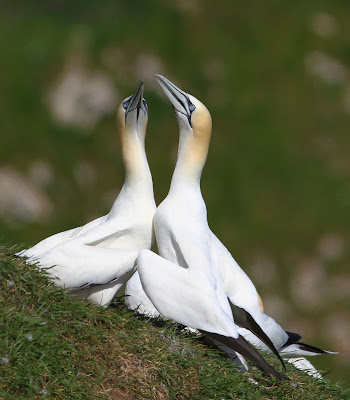For some reason I can't think about Monty's Harrier without being reminded of a famously sweary line from
Withnail and I. This doesn't happen very often, as they have become a very rare breeding bird in Britain, having started off being not very plentiful in the first place. After an early start from Dorset
en route to a
Gannet-fest at Bempton cliffs for a couple of days, I was able to call in at another RSPB reserve, Blacktoft Sands, where a pair have set up shop this year.
 |
| Male Montagu's Harrier, Blacktoft Sands |
 |
| A very slim and elegant raptor |
 |
| Here the male and female together |
Records of breeding Monty's are usually kept pretty quiet but once in a while a pair will turn up somewhere like this where they can be kept an eye on and birders can be encouraged to see them there where the risk of disturbance is low rather than go looking for them elsewhere. Keep up to date with the progress of the breeding pair
here. Always distant, though the female got up for a stretch and did a circuit which brought her a fair bit closer than the male.
 |
| Female Montagu's Harrier |
 |
| Showing the white tail band here |
 |
| The female Monty's looked very rufous in the field |
Marsh Harrier and Avocet used to be rare breeders in Britain not so long ago but both have seen an upturn in their fortunes - and both were plentiful at Blacktoft. They weren't getting along too well though as several passing Marsh Harriers experienced the wrath of nervous Avocet parents intent on protecting their newly fledged chicks.
 |
| Marsh Harrier mobbed by Avocet |
 |
| A Grey Heron gets similar treatment |
 |
| Marsh Harrier |
On the way back south I detoured via the Brecks for a day to see another rare breeder which I haven't seen for a few years - Stone Curlew at the Norfolk Wildlife Trust reserve on Weeting Heath. Four adults were present and I glimpsed a couple of fluffy chicks tottering around in the long grass too.
 |
| Stone Curlew, Weeting Heath (#188) |
 |
| The birds were very vocal in the early morning |
 |
| The hides at Weeting Heath are a reliable place to see Stone Curlew without the risk of disturbing the birds |
Just around the corner from Weeting Heath is Lakenheath Fen, the third major RSPB reserve on my itinerary. A Little Bittern had been barking there for a week, but chose the day of my arrival to go elsewhere. Frustratingly, it was back again today after a two day absence which coincided with my visit.
 |
| Common Cranes, Lakenheath Fen (#189) |
 |
| Cuckoo among the Poplars which used to ring with the sound of Golden Oriole song |
 |
| Interpretation board at Lakenheath |
Lakenheath used to be a reliable breeding site for Golden Oriole but although a male sang briefly there earlier in the month, they appear to have given up the ghost in recent years. Very sad, but a distant view of a pair of Common Cranes, which returned to the Fen to breed in 2007, made up for the disappointment of not seeing the Little Bittern.
 |
| Jay with what looked like a Great Tit chick. |
 |
| Whitethroat, Lakenheath - more showy than... |
 |
| ...Lesser Whitethroat, taken back in Wareham last week (#190) |



























































